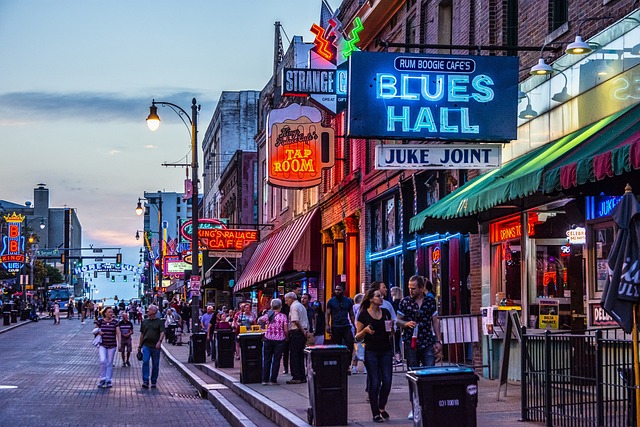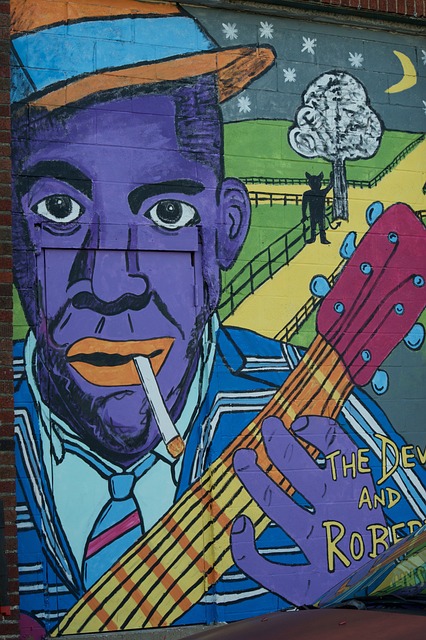Embarking on the Blues Trail is not merely a physical journey; it’s a pilgrimage through time, tracing the footsteps of blues legends and immersing oneself in the rich history of this profoundly influential genre. As we navigate the winding paths of this musical odyssey, we encounter the hallowed grounds, juke joints, and historic sites that have shaped the blues narrative.
Clarksdale, Mississippi: The Birthplace of the Blues
Our journey commences in the heart of the Mississippi Delta, in the quaint town of Clarksdale. Known as the birthplace of the blues, this small community has given the world some of its most iconic blues figures. The crossroads of Highways 61 and 49, where legend has it Robert Johnson sold his soul to the devil in exchange for musical prowess, is a must-visit landmark. The Delta Blues Museum stands as a testament to the roots of the genre, showcasing artifacts and memorabilia that tell the story of blues pioneers.
Beale Street, Memphis: Where the Blues Come Alive
Moving north, our next stop is the vibrant Beale Street in Memphis, Tennessee. A hub of blues activity since the early 20th century, Beale Street has played host to legendary performers such as B.B. King, Muddy Waters, and Howlin’ Wolf. The Beale Street Historic District, with its neon lights, soulful tunes pouring out of clubs, and the historic A. Schwab General Store, offers a glimpse into the heyday of the blues. Take a stroll down this iconic street, and you’ll feel the spirits of blues musicians echoing through the brick-lined sidewalks.

Sun Studio: The Birthplace of Rock ‘n’ Roll
A short distance from Beale Street, Sun Studio beckons as a pivotal landmark in the blues narrative. Known as the birthplace of rock ‘n’ roll, this unassuming recording studio witnessed the early careers of blues legends such as Howlin’ Wolf and B.B. King. The guided tour through Sun Studio is a sonic journey through time, allowing visitors to stand in the same room where Elvis Presley, Johnny Cash, and Jerry Lee Lewis once recorded.
Chicago’s South Side: The Urban Blues Experience
Transitioning from the rural origins of the blues, our trail leads us to the electric blues scene that thrived on Chicago’s South Side in the mid-20th century. Bronzeville, with its historic blues clubs like the Checkerboard Lounge and Theresa’s Lounge, was a melting pot for blues innovation. Muddy Waters, Willie Dixon, and Buddy Guy are among the luminaries who contributed to the urban blues experience that transformed the genre into a powerful, electrified force.
The Crossroads, Clarksdale, and Beyond: Delta Legends
Returning to the Delta, we pay homage to the musicians whose names are etched in blues history. The Crossroads, synonymous with the myth of Robert Johnson, serves as a symbolic meeting point of blues folklore. As we traverse the Delta region, landmarks like Dockery Plantation, where Charley Patton honed his craft, and the grave of Sonny Boy Williamson II, offer glimpses into the lives of those who birthed the Delta blues.
Stax Museum of American Soul Music: Where Blues and Soul Converge
In Memphis, our journey takes a detour to the Stax Museum of American Soul Music. While predominantly celebrated for its contribution to soul, Stax Records played a pivotal role in the intersection of blues and soul. Artists like Otis Redding and Albert King recorded here, leaving an indelible mark on the evolving soundscape of American music. The museum houses artifacts that capture the soulful essence of this influential era.
The Mississippi Blues Trail: A Historical Mosaic
Our Blues Trail adventure wouldn’t be complete without exploring the Mississippi Blues Trail. This extensive network of markers and interpretive sites weaves a historical mosaic, telling the stories of blues artists, venues, and events that shaped the genre. From the birthplaces of B.B. King and Muddy Waters to the historic train depots where blues musicians once played, the Mississippi Blues Trail is a comprehensive exploration of the genre’s roots.
New Orleans: The Birthplace of Jazz and Blues Fusion
As we conclude our journey, we venture to the vibrant city of New Orleans, where the blues fuse with jazz to create a unique musical tapestry. The Preservation Hall, nestled in the French Quarter, is a testament to the city’s musical heritage, hosting performances that seamlessly blend blues, jazz, and traditional New Orleans rhythms. The historic Faubourg Treme neighborhood, with its deep musical roots, provides a fitting finale to our exploration of the Blues Trail.

In essence, the Blues Trail is a musical pilgrimage, offering a profound connection to the roots, evolution, and cultural impact of the blues genre. It’s a journey that transcends time, inviting enthusiasts to walk in the footsteps of legends, feel the echoes of soul-stirring melodies, and witness the living history of a genre that continues to captivate hearts around the world. Join us on this blues odyssey, and let the trail resonate with the timeless spirit of the music we love.
